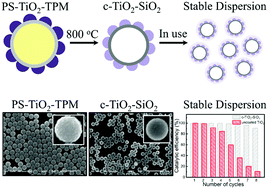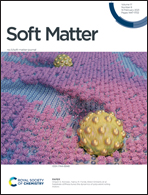Stabilisation of hollow colloidal TiO2 particles by partial coating with evenly distributed lobes†
Abstract
Photo-catalytically active crystalline TiO2 has attracted special attention due to its relevance for renewable energy and is typically obtained by the calcination of amorphous TiO2. However, stabilising hollow colloidal TiO2 particles against aggregation during calcination without compromising their photocatalytic activity poses two conflicting demands: to be stable their surface needs to be coated, while efficient photocatalysis requires an exposed TiO2 surface. Here, this incompatibility is resolved by partially coating TiO2 shells with evenly distributed 3-trimethoxysilyl propyl methacrylate (TPM) lobes. These lobes act both as steric barriers and surface charge enhancers that efficiently stabilise the TiO2 shells against aggregation during calcination. The morphology of the TPM lobes and their coverage, and the associated particle stability during the calcination-induced TiO2 crystallization, can be controlled by the pH and the contact angle between TPM and TiO2. The crystal structure and the grain size of the coated TiO2 shells are controlled by varying the calcination temperature, which allows tuning their photocatalytic activity. Finally, the durable photocatalytic activity over many usage cycles of the coated TiO2 compared to uncoated shells is demonstrated in a simple way by measuring the photo-degradation of a fluorescent dye. Our approach offers a general strategy for stabilising colloidal materials, without compromising access to their active surfaces.



 Please wait while we load your content...
Please wait while we load your content...